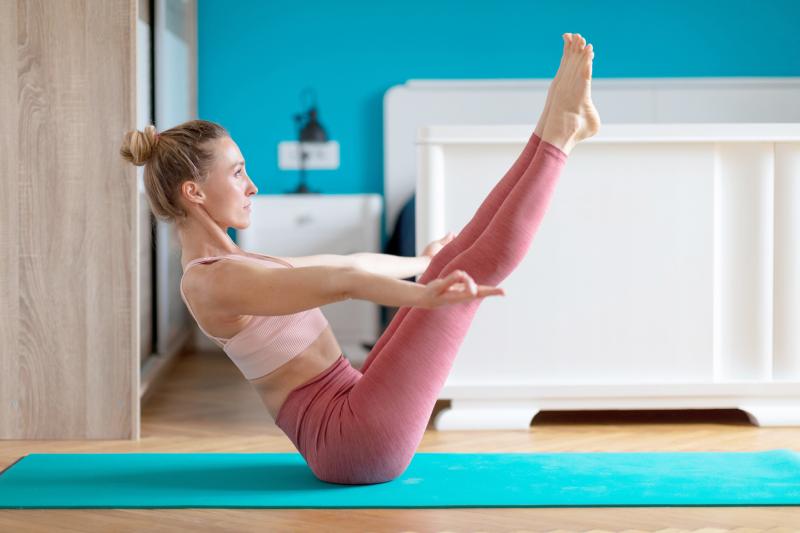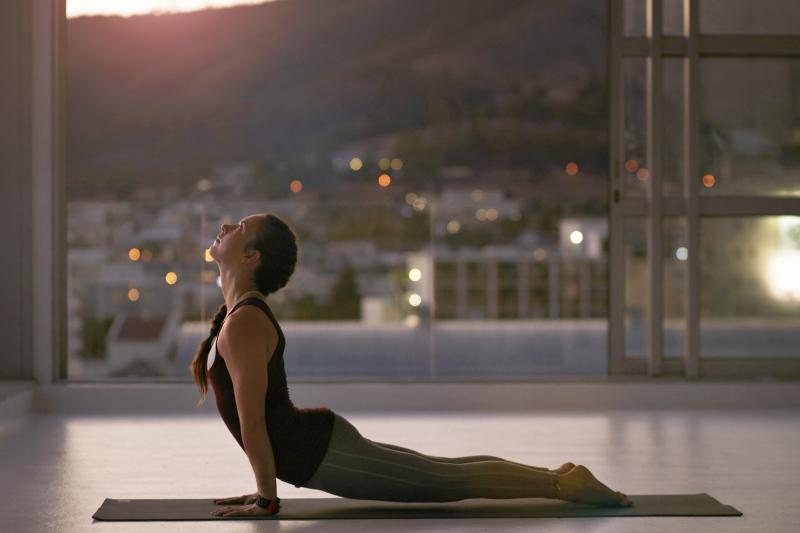
If you've been practicing yoga for a while and have gotten comfortable with the basic poses, you may want to consider adding some intermediate poses into your practice. Intermediate yoga poses deepen your basic practice by demanding more of you: more strength, better balance, and heightened attention.
Mastering intermediate poses can be empowering. Whether you are balanced completely on your arms, twisted like a banyan tree in a towering vertical line, or sitting solidly on just your sit bones relying solely on your core for stability, you can take pride in the work you've done and look forward to even greater attainment as your practice progresses.
8 Intermediate Yoga Poses to Try
Yoga is an incremental endeavor. When you're ready, take charge of your practice by slipping in a few of these intermediate poses to capitalize on your progress and challenge yourself. As tight muscles relax and you get stronger, you'll surprise yourself with the poses you never thought you'd be able to do.
Half Moon Pose
Half moon pose is you, standing tip-tilted on one leg and one hand, with one arm reaching for the heavens and one leg fully extended, half of you supporting the other half of you in space. The pose strengthens your thighs, ankles, glutes, spine, and abs while it stretches your chest, back, shoulders, calves, hamstrings, and groin. Your balance gets a boost, and your stress level decreases. If you have trouble reaching the floor with your arm at first, use a yoga block to modify the pose.
Eagle Pose
Eagle pose is an asana of real focus. Like the eagle, you take the long view while homing in on the details that feed your power. Standing strong on one leg, the other leg wrapped around your calf, both arms entwined in front of your chest with hands pointing up, you are stable, breathing calmly, and balanced. The work you did to improve flexibility in basic poses pays off now in stronger ankles and calves, better concentration and balance, and good stretches for the upper back, shoulders, hips, and thighs. Work toward being able to hold eagle pose for several breaths.
Crow Pose
Crow pose is too cool. It looks impressive because it is impressive. As you assume an extreme tuck, facing your mat and supporting yourself on the palms of your hands, knees stabilized against the backs of your arms, you're doing a lot more than working your arms and wrists. Crow pose strengthens your abs and tones your abdominal organs, opens your groin, and stretches your upper back. Did you notice it looks awesome? Yeah, that, too.
Shoulder Stand Pose
Shoulder stand, like all the inversions, is a like holiday for your brain. When you're balanced on your shoulder blades, back supported by your arms and hands, legs extended straight up, you're defying gravity just that little bit, and it's so restful. It also provides a great neck and shoulder stretch. Shoulder stand is an intermediate pose because you can injure your delicate neck if you're not strong or careful enough to pull it off safely. Always work with the support of a towel or blanket folded under the upper back and shoulders so your neck doesn't get crunched.
Plow Pose
Plow pose is another upside-down (sort of) feel-good. Once again, you need a blanket or towel to protect your neck as you stretch both arms along the floor at your sides; you can clasp your hands or place your palms flat on the floor or mat. Your extended legs go up and over your head to rest on the floor behind your head, toes on the floor, knees relaxed but unbent.
Breathe evenly in the plow, not shallow, and relax as you stretch your shoulders and spine, lower stress, re-energize, relieve sinus pressure, and lose a few aches and pains in your back and neck. This pose is also believed to stimulate your thyroid and abdominal organs. This pose is intermediate because you need strength and flexibility to reach the floor overhead with your feet without endangering or compressing your neck.
Boat Pose
Boat pose might seem simple, but it is quite challenging. You are balanced on your tailbone and sitting bones, with your torso and head aligned in one-half of a "v." Your extended legs form the other half. Your arms may be extended straight along your sides with palms facing your body, or fully extended, palms down, parallel to your legs. Of course, you are breathing evenly and slowly, not stressing your neck and upper back at all, because your core is holding the beautiful boat shape in place. Right? Practice makes perfect.
Upward Facing Dog
Upward-facing dog does for your spine what a downward dog does for your hamstrings. You're facing the mat with your legs extended, feet unflexed. Your arms are in a pushup position, and then you do push up, reaching your head high, lifting and opening your chest, extending your arms fully, and pushing your palms strongly into the floor.
Keep those shoulders away from your ears as you engage your core and really feel the stretch in the backbend. The upward-facing dog pose improves your posture as it opens your lungs, chest, and shoulders, strengthens your spine, arms, and wrists, tightens your flabby glutes, and stretches your tummy. This is an energizing, pose that makes your tense back happy and may help combat depression.
Camel Pose

Camel is a fun pose but, reaching your hands all the way to your ankles requires being very flexible. Don't let that stop you. You could use a yoga block or a chair as a prop. In this pose, your shins and the tops of your feet rest on the floor and you reach back to rest your hands lightly on your heels or ankles, then you give yourself over to a long deep backbend.
Camel pose stretches your entire front, from chin to ankles. It opens and loosens your chest, belly, throat, and hip flexors. At the same time, you're working your back muscles and improving your posture. Hang out in camel pose for a few rounds of breath, if you can breathe deeply and evenly and experience no muscle fatigue in the position.
As you build your practice, remember that it's not a competition. You should aim first for deeper focus and good form. However, varying asanas and tackling new ones when you're ready can be as satisfying as that initial smooth, flowing sun salutation that's no longer bumpy or stop-and-start as you move from beginner to intermediate rank in the next stage in your yoga adventure.














